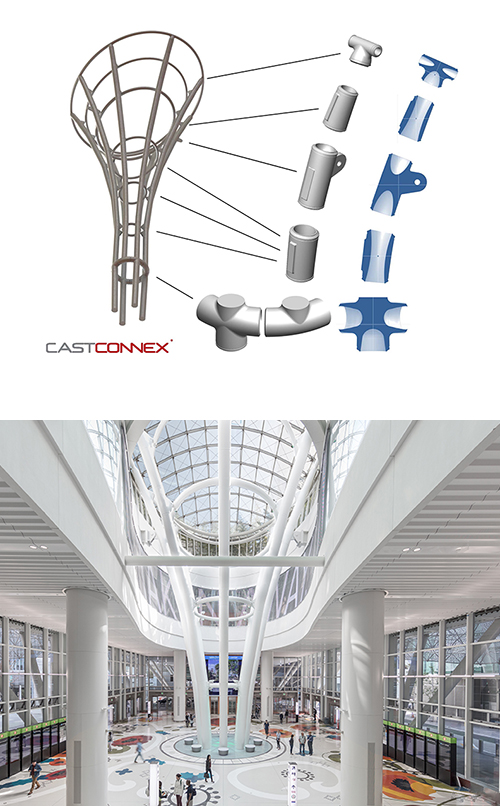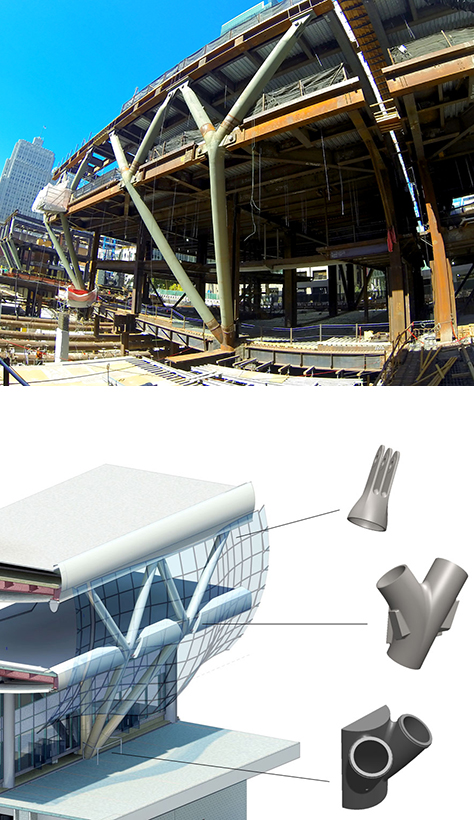The Capabilities, Value and Opportunity of Designing With Steel Castings
Peer Perspective: Carlos de Oliveira, Cast Connex Corporation
We spoke with Carlos de Oliveira, CEO and co-founder of Cast Connex Corporation, to hear his thoughts on how steel castings compare to conventional fabricated connections. His insights on cost savings, ease of fabrication and aesthetic advantages are illuminating.
Q: Carlos, you have a storied background in the space. Can you tell us a bit about your current role, give a brief overview of your experience, and share how you became interested in castings?
A: I’m the president and CEO of Cast Connex Corporation and also a co-founder of the company. I founded the company with a grad student colleague of mine — Michael Gray — and two professors from the civil engineering department at the University of Toronto in 2007. The idea originated from research we started in 2004 studying how castings can improve various types of connections, particularly tubular connections for seismic-resistant braced frames. My thesis supervisors, Dr. Jeffrey Packer and Dr. Constantin Christopoulos, were looking at connections for seismic-resistant tubular bracing and asked me to explore solutions using castings. I had to learn about the challenges around conventionally fabricated connections for tubular, seismic-resistant bracing and also had to learn everything about casting manufacturing so that we could best understand how to leverage castings to solve the problem. It was pretty exciting for me as someone who is really drawn to structural mechanics. When I finished my master’s degree, we founded Cast Connex.
Q: How would you say access to castings has changed in recent years? In what ways have you been able to affect the market to make them a more viable option for designers?
A: There was a gap in terms of design guidance and capability for leveraging castings in construction. During our research, we looked globally at how castings were being used in civil structures. We saw impressive, widespread use of castings in other industries and significant use of castings in civil structures abroad in Europe and in Asia. Surprisingly, there was a tremendous gap in terms of North American use.
Fortunately, the expertise that we developed during our research provided us with an opportunity to bring castings to the North American market. And when we did that, we started by putting a North American spin on it, in that we started with offering standardized connections targeted toward arduous structural or architectural applications. By standardizing, we’re able to produce castings in high volume and really provide a very economical solution for use in a wide range of structures and applications. We’re seeing tremendous benefit and value in producing resilient, better-performing, lower-cost structures using castings.
Q: How do you explain castings, the opportunities they afford and what their best uses are?

A: Tubular steel starts as a rolled-plate product and then it’s cold-formed into the shape. For example, if you’re making A500 or A1085 tubular products, it’s cold-rolled and formed into the shape, and that process actually elevates the strength of the steel. Whereas in castings, we pour molten metal into a mold, it freezes in the mold, and then we use heat treatment to attain the mechanical properties. At the end of the day, when designed appropriately, castings provide very similar — if not improved — mechanical properties to conventional rolled-steel products.
So with castings, we have an ability to make geometries that are otherwise unable to be produced. We can make shapes that range in geometry or in thickness. Say, for example, from very thick to very thin sections that curve in ways that you could never roll, bend or weld steel shapes together to produce. Effectively, we can put the material where it should be for the flow of forces through the connection or the component. Then we can produce steel in grades that have elevated strength, toughness or ductility, allowing us to produce components that are better optimized and better performing to address complex stress states in complex connections.
Q: Can you expand a bit on creating unique geometries with castings and what some unexpected possibilities might be?
A: Sure. With rolled steel, you’re stuck with the standardized steel shapes. If you’re trying to make a connection, you’re cutting plates and shapes and welding them together, and you’re stuck with certain geometries. Weld access can be an issue. And when connections are heavily loaded, there is a lot of labor cost that must go into building fabricated connections. With castings, it’s a clean slate, so you can just make the shape as it should be. There’s tremendous architectural potential as well to create geometries that offer a certain aesthetic and appeal.
We’re natural beings, and we’re used to seeing nature respond in a sensible way to the forces that are applied to it. A tree, a rose petal and the wing of a bat all look the way they do because forces shaped the evolution of those geometries in nature. Similarly, when we put the material where it should be for the flow of forces through a structural connection, we, as natural beings, are intuitively attracted to those shapes. Castings provide an opportunity to create beautiful, graceful-looking structural components to carry the forces the way they ought to flow through these connections.
Most casting uses are within two general realms: heavily loaded, complex connections in structures or architecturally exposed connections. And when you have connections that are both, it’s an even better application for castings. If you have a connection that’s going to be exposed to view in the finished condition and it’s heavily loaded or has a very high importance to the overall structural function of the overall building, then that’s usually a fantastic application.
Additionally, a tremendous amount of cost and risk in construction is in the field when the structures we design are actually being built. Designers can leverage the free-form capabilities of castings to simplify field activities, say by eliminating the need for field welding, or can reduce risk by leveraging the tremendous improvement in tolerances that are afforded by castings.
Q: We’ve seen some stunning photos of the Salesforce Transit Center project. Can you tell us a little bit about the role Cast Connex played in the construction?

A: Yes, it really is an incredible project because of its significance to the city of San Francisco. It’s a multimodal transit hub located right in the heart of downtown, so it’s a very important structure. Because of where it’s located, it has to be able to resist very significant earthquake-induced loading. It’s a very large structure, spanning about three city blocks and traversing two city streets. And it’s an interesting structure because the steel that does most of the work to help that building resist earthquake loading, and which also supports a tremendous amount of the gravity load in the structure, is actually on the outside. It’s an exoskeletal structure, and this exoskeleton is comprised of very large-diameter steel tubes connected at each location with cast steel nodes.
The reason steel castings were used at those critical connection points is that there are tremendous forces that have to be transmitted between those tubular members, particularly in the event of an earthquake. It’s very complex from a geometric perspective. With castings, we’re able to address that geometry, address those loads and also do it gracefully, which is important because that steel exoskeleton is architecturally exposed structural steel, so it’s visible in the finished condition while also performing a very important structural function.
Q: What’s one last grain of wisdom or key takeaway you’d like to share?
A: As with any design guidelines, tubular connections have certain ranges of applicability, and there are ranges that are defined in the code that can be very restrictive from a design perspective. So if intersecting angles of tubular members are very tight, you could run into a situation, for example, where the code simply says you can’t address that connection using a conventional tube-to-tube connection. Other concerns include local connection limit states or stiffness that can end up governing and driving steel tonnage in the structure. So users of tubular steel should really consider castings anytime they’re running into challenges where their connections are driving member selection.
People often ask, “What are the economics of castings? When do castings make sense?” The short answer is that while castings, on a per-ton basis, are more expensive than conventional fabricated connections, cast connections are typically lighter than their fabricated alternates. And when you use castings, you not only save tonnage in the connections, you can also significantly reduce tonnage in the entire structure. That’s why asking whether a cast or fabricated connection is more expensive misses the point because castings can provide tremendous overall project cost savings by reducing the tonnage of the structures they’re used in and by simplifying construction and fabrication. And since cast connections are better optimized and outperform fabricated connections, their use results in structures that are more resilient, longer lasting, better performing and more rational.
For more information on castings, read STI’s article, Connecting to Structural Castings.
October 2020